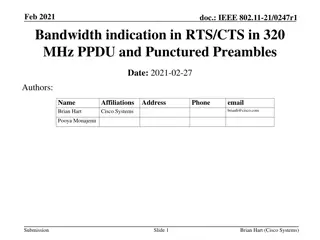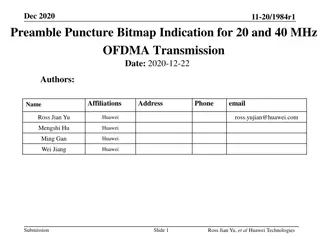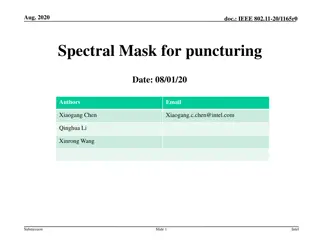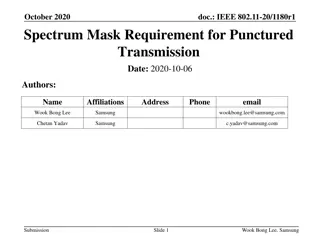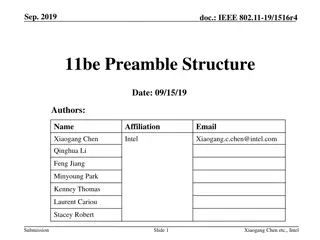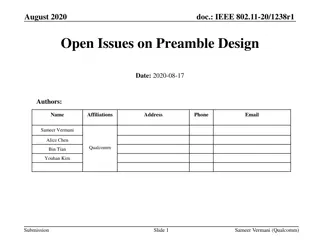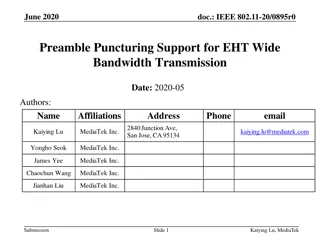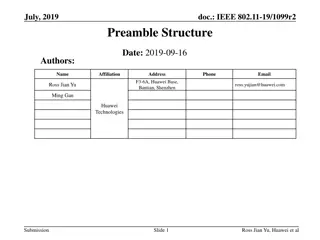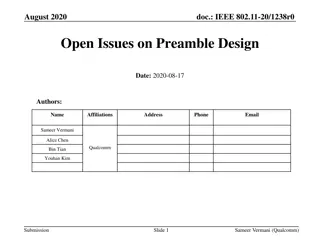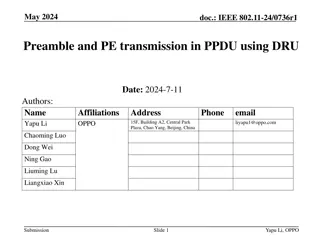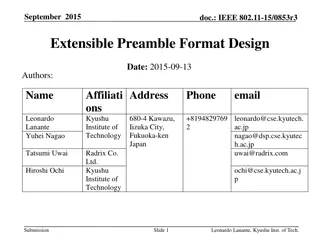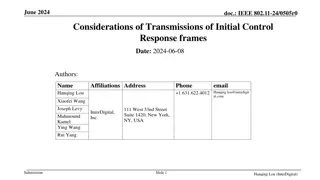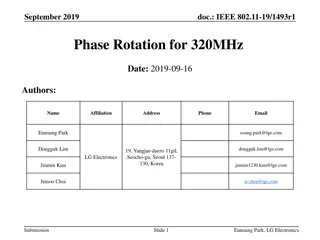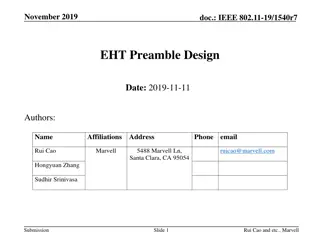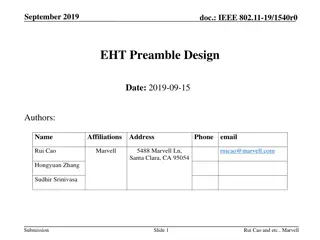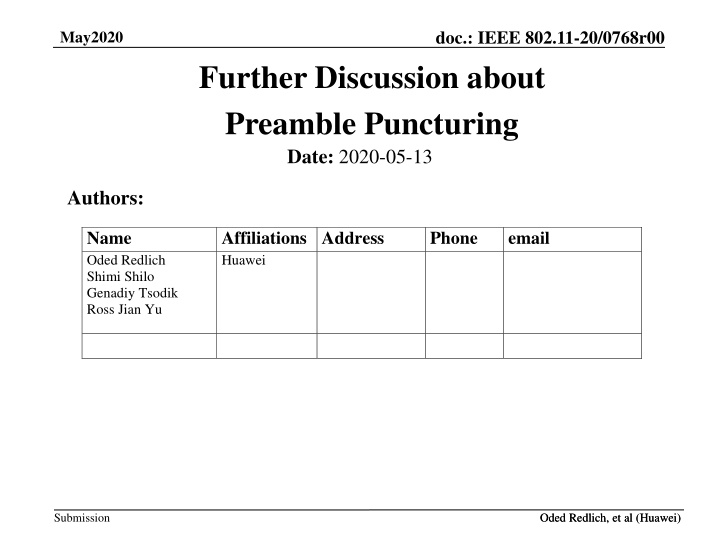
IEEE 802.11-20/0768r00 Preamble Puncturing Discussion
"Explore further discussion on non-supported puncture patterns in IEEE 802.11-20/0768r00 May 2020 document. Learn about unsupported patterns, conclusions, and real-life scenarios challenging initial assumptions."
Download Presentation

Please find below an Image/Link to download the presentation.
The content on the website is provided AS IS for your information and personal use only. It may not be sold, licensed, or shared on other websites without obtaining consent from the author. If you encounter any issues during the download, it is possible that the publisher has removed the file from their server.
You are allowed to download the files provided on this website for personal or commercial use, subject to the condition that they are used lawfully. All files are the property of their respective owners.
The content on the website is provided AS IS for your information and personal use only. It may not be sold, licensed, or shared on other websites without obtaining consent from the author.
E N D
Presentation Transcript
doc.: IEEE 802.11-20/0768r00 May2020 Further Discussion about Preamble Puncturing Date: 2020-05-13 Authors: Name Oded Redlich Shimi Shilo Genadiy Tsodik Ross Jian Yu Affiliations Address Huawei Phone email Submission Oded Redlich, et al (Huawei) Oded Redlich, et al (Huawei)
doc.: IEEE 802.11-20/0768r00 May2020 Outline Non-Supported puncture patterns Examples 1001 puncture patterns Conclusions SPs Appendix Submission Oded Redlich, et al (Huawei) Slide 2
doc.: IEEE 802.11-20/0768r00 May2020 Non-Supported puncture patterns There are 3 non-supported puncturing patterns: 1001 , 1010 , 1000 , The first 2 failed to pass SPs: 1001 with marginal results: Y/N/A 31/13/16 1010 with a clear NO : Y/N/A 17/34/19 One of the claims was that the non-supported patterns are not likely to occur due to channel plan considerations. The standard defines (section 11.40.2 in 802.11-2016, see Appendix) that if an AP chooses a P80 that is already being used by an OBSS, then it must use the same P20 used by the existing OBSS. Hence, it may seem reasonable not to support the above described puncturing patterns, specifically 1001 Submission Oded Redlich, et al (Huawei) Slide 3
doc.: IEEE 802.11-20/0768r00 May2020 Non-Supported puncture patterns However in real life this is not the case: 11n/ac APs choose P20 arbitrarily, so an OBSS with different primary channels are not restricted to the disappearing legacy devices In other words, the unsupported puncture patterns occur far more often than was initially assumed! Therefore, we would like to reconsider the 1001 pattern We observe that pattern 1001 has more resemblance to the supported pattern of 1011 Both 1001 and 1011 have 2 CC Both 1001 and 1011 have the same ACI level due to the existence of a single hole. In the next slides we show some examples of measurements taken in residential environments, which demonstrate how P20 is actually chosen by APs. Submission Oded Redlich, et al (Huawei) Slide 4
doc.: IEEE 802.11-20/0768r00 May2020 Example #1 In these examples we see several APs sharing channel 42 (80MHz). In the upper figure the brown AP, which uses channel 44 as P20, sees 2 APs that use different channels as P20: channels 40 & 48 In the lower figure, the blue AP uses Channel 48 as P20 and the green AP uses channel 44 as P20 So in both examples the APs choose their P20 in contrast to the standard definitions Note: the APs are from different vendors Submission Oded Redlich, et al (Huawei) Slide 5
doc.: IEEE 802.11-20/0768r00 May2020 Example #2 In this example we show that APs may be configured by the end-user to use a fixed channel We see 2 APs that operate in a 20MHz BSS BW, each of them in a different channel (36, 48) Of the other six 80MHz APs, two use channel 36 and four use channel 40 as their primary channel So again standard rules are most likely not obeyed: Because there are many 80MHz APs here, it is likely that there is at least one 80MHz APs that uses a primary channel (e.g. 36) which is a secondary channel of an existing OBSS (e.g. 40) A 20MHz AP (e.g. the yellow one) overlaps with S20 of some of the 80MHz APs (all the APs that use channel 40 as their primary channel) Submission Oded Redlich, et al (Huawei) Slide 6
doc.: IEEE 802.11-20/0768r00 May2020 1001 Puncture Pattern So how may puncture pattern 1001 be obtained? puncture pattern 1001 is likely to be obtained when 2 devices that use different channels as P20 (one chooses channel 40 and the other chooses channel 44), choose to reduce to 20MHz PPDU In order to transmit to a legacy PPDU or To operate as a 20MHz BSS BW device In this case, a third device that uses channel 36 or 48 as P20, would see 1001 pattern 20MHz PPDU 20MHz PPDU Sees puncture pattern 1001 Channel#: 36 40 44 48 Channel 42 (80MHz) In addition to the above-mentioned assumptions, and as described in [1] & [2], 1001 may also occur due to a 30MHz incumbent signal (expected to be relatively common in >6GHz band) that overlaps with the two middle 20MHz channels Submission Oded Redlich, et al (Huawei) Slide 7
doc.: IEEE 802.11-20/0768r00 May2020 Conclusions As shown in the examples, this pattern is likely to occur in real life Practically there is no real limitation that prevents us from supporting this pattern: All passed motions respective to preamble detection, specifically U- SIG and EHT-SIG, are valid with this pattern Both CCs are available, so preamble detection may be done on P80 only Per-80MHz detection (e.g. for supporting parking channels) is possible as well for the same reason Moreover, unlike patterns that include a single 20MHz hole, the 1001 pattern may coexist with incumbent 30MHz signals We suggest to reconsider supporting the 1001 preamble puncture pattern P80MHz S80MHz Submission Oded Redlich, et al (Huawei) Slide 8
doc.: IEEE 802.11-20/0768r00 May2020 Straw Poll #1 Do you agree to allow puncturing structure 1001 in a given 80MHz segment for OFDMA PPDUs transmitted to STAs operating at BW>=80MHz? Assuming 2 content channels are used. Puncturing signaling may be different for different 80MHz channels. Y- N- A- Submission Oded Redlich, et al (Huawei) Slide 9
doc.: IEEE 802.11-20/0768r00 May2020 Straw Poll #2 Do you agree to allow puncturing structure 1001 in a single 80MHz segment for non-OFDMA PPDUs? The hole that exists in the 1001 segment is the only hole in the entire BW. For BW>80MHz the other segments shall not be punctured. Y- N- A- Submission Oded Redlich, et al (Huawei) Slide 10
doc.: IEEE 802.11-20/0768r00 May2020 References [1] 11-19-1908-04-00be - Multi-RU Support (Ron Porat, BRCM) [2] 11-20-0048-00-00be - Large RU Aggregation for 240 and 320 MHz (Bin Tian, Qualcomm) Submission Oded Redlich, et al (Huawei) Slide 11
doc.: IEEE 802.11-20/0768r00 May2020 Appendix Submission Oded Redlich, et al (Huawei) Slide 12

